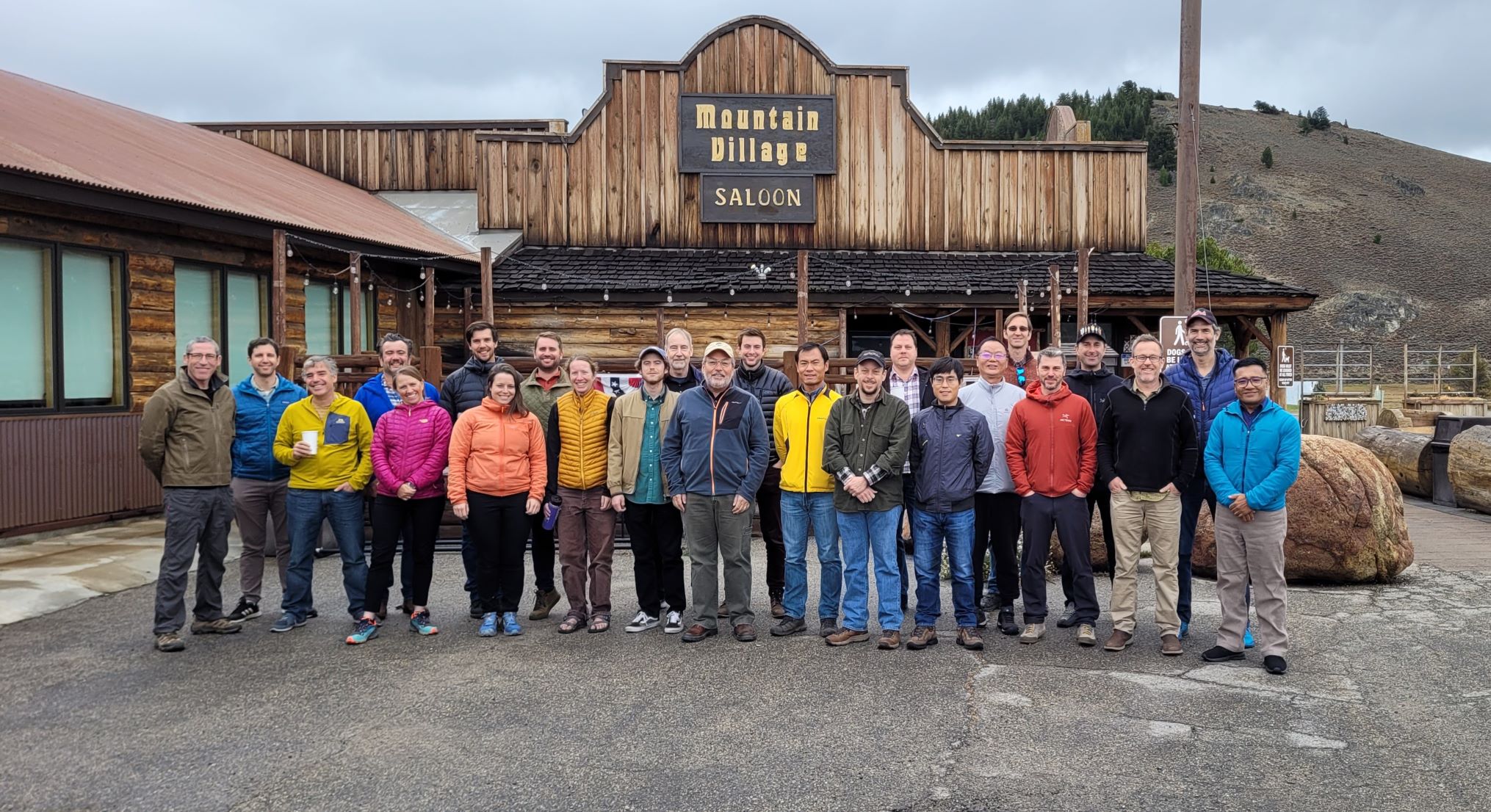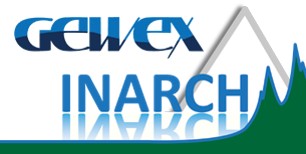Workshop Overview
Our 2023 annual INARCH Workshop was held October 9–11, 2023 in Stanley, Idaho, USA at the Mountain Village Resort. Professor James McNamara, Dr. Ernesto Trujillo-Gomez, and Dr. Andrew Hedrick were our 2023 workshop hosts.
Ahead of the workshop, participants toured and learned about the hydrology and science at the Dry Creek Experimental Watershed outside of Boise. The tour was led by Jim McNamara, Ernesto Trujillo-Gomez, and Maggi Kraft. After the workshop, participants went for a full day tour of the Reynolds Creek Experimental Watershed in the nearby Owyhee Mountains, led by Andrew Hedrick and several of the research technicians and staff.
See the workshop agenda
See summary article published in GEWEX Quarterly

Presentations
Introduction
- Summary and Overview of INARCH 2023, John Pomeroy
Sessions 1 & 2, Observations and Measurement Techniques
- Transitioning from probing to droning: Improving spatial representation of snow processes and reducing personnel risks, Andrew Hedrick
- Sublimation from Drifting Snow, Ethan Gutmann
- In-scaling snow measurements in mountainous terrain, Eric Sproles
- Snow cover and frozen ground observations in Heihe River basin, Qilian mountain, Tao Che
- Monitoring the vanishing of the Pyrenean glaciers, Nacho López-Moreno
- An intro to the Wolverine Glacier and surrounding watershed research, Anna Bergstrom
- COPE Monitoring in the Canadian Rockies Hydrological Observatory, John Pomeroy
- Transitions in the semiarid mountain west: Snow to rain and streamflow to ET, Maggi Kraft
- Investigating high altitude cryosphere – surface water – groundwater interactions in Langtang, Nepal Himalaya, Caroline Aubry-Wake
- Advancing high--resolution snow simulations for the resolution snow simulations for the DischmaDischmacatchmentcatchment, Jan Magnusson
- New insights of water sources and pathways across a latitudinal and altitudinal gradient, Yukon, Canada, Sean Carey
Sessions 3 & 4, Observations and Modelling
- CRHM Modelling of the Nepal Himalayas, Dhiraj Pradhananga
- Quantifying contributions of runoff components to streamflow in Central Asian glacierized basins, Zhihua He
- Evaluation of Process-based Hydrological Modelling in Canadian Rockies Headwater Basins, Logan Fang
- Precipitation Rescaling Approach to Represent Snow Distribution in the iSnobal model and its Effects on the Snowpack Mass and Energy Balances, Ernesto Trujillo
- Groundwater storage loss and associated streamflow declines -- Implications of warming in the East River, Colorado, Rosemary Carroll
- From Snowflake to Snowpack: How do Cloud Microphysical Representations Influence Hydrologic Response? Alejandro Flores
- Preliminary results from the Upper Renegado River (Valle Hermoso) Catchment: fieldwork and modeling activities, Sebastián Krogh
- Forecasting seasonal snow with million km2 large-extent snowdrift-permitting simulations, Chris Marsh
- An Investigation of the Processes that Produce Patterns of Snow Refugia in Complex Terrain, Tim Link
- Hydrological Prediction in High Mountains - Andes, James McPhee
- The Influence of Meteorology on Canopy Snow Ablation, Alex Cebulski
Session 5, COPE and other updates over Zoom
- Comprehensive study of heat and water exchange process and its climatic effects over the Third Pole, Yaoming Ma
- Experimental observation of hydrological processes in the Tibetan Plateau, Zhongbo Yu
- News from the Rofental (Austria), Ulirich Strasser
- Advances in glacio-meteorological monitoring - examples from Hintereisferner, Austria, Rainer Prinz
- Update on cryo-hydro-gravimetric measurements and other activities at Mt. Zugspitze, Germany, Franziska Koch
- Update on Sentinel-2 and Pléaides processing for INARCH sites, Simon Gascoin
Session 6, COPE data management and planning
- Further updates and status of INARCH Common Observing Period Experiment (COPE), Chris DeBeer
- Updates to INARCH portion of GWFNet catalogue, Stephen O'Hearn
Closing
- INARCH 2023 Closing, John Pomeroy
Session Summaries
Summary of Observatories and Measurement Techniques
- Snow depth from UAVs (Structure from Motion, LiDAR) is expanding and replacing snow surveys, this and new sensors (gamma, cosmic ray, terrestrial lidar, GPS, gravity meters) are adding to valuable snow and glacier records.
- Sublimation and transport of blowing snow can be large components of the alpine water balance being quantified along with overwinter snowpack ablation and redistribution.
- Scale effects on snow distribution are crucial in mountain basin hydrology….
- Frozen ground, snow and land surface fluxes need to be understood together in High Mountain Asia
- Rapid disappearance of glaciers in many mountain ranges including Pyrenees and Canadian Rockies.
- The importance of groundwater to mountain glaciated and non-glaciated basin hydrology is increasingly understood but more needs to be done to quantify this
- Isotopes and other tracers are useful tools for understanding the water balance, glacier mass balance, and the hydrological functioning of alpine sites. Possibility to create working group in INARCH to improve their usability and link to models.
- There is a challenge in dealing with precipitation and snow redistribution as they affect glacier mass balance
- The link between snow hydrology and ET is tight and shifting in many mountain basins – linked to phase change, which also affects glacier hydrology very strongly
- Downstream droughts and water management problems affected by climate change and strongly affected by extremes, including destabilisation of groundwater regimes and impacts on baseflow.
- Isotopes are showing the stability of or changing flow pathways in linking snowpacks, glaciers, subsurface and streamflow
- Ecosystem sustainability through snow refugia that are only partially understood, but link to forest structure and complex terrain drainage.
- New understandings of forest snow interception processes including unloading and entrainment are being developed
Summary of Observations and Modelling
- Fully coupled snow atmospheric and hydrology models including redistribution are being applied operationally for snow hydrology forecasting in mountain regions and informed by research basin observations.
- Coupled glacier and snow hydrology with groundwater models are being developed and applied but with great uncertainty for groundwater parameterisations.
- Isotopes are being integrated into physically based glacier and snow hydrology models and need regular isotopic measurements for further development
- Integration of airborne LiDAR shows promise to set initial boundary conditions or parameterisations for snow and other hydrological models – where available.
- Improvements to convective permitting atmospheric models will permit more reliable forcing in complex terrain.
- Snow interception modelling is progressing in non-needleleaf forests and is promising
- Snow-drift permitting (<100 m), hyper-resolution modelling of snow redistribution and melt in complex terrain is now possible and is being deployed at continental scales with credible results.
- Coupled hydrological land surface schemes that account for glaciers, slope-aspect, elevation and snow processes have global applicability for river basin hydrology for rivers with mountain headwaters.
- New, object oriented and flexible models are available and tested for snow and glacier hydrology processes.
- Remarkable datasets have been collected in the Tibetan Plateau region for hydrometeorological, snow and glaciological systems that are being examined for trends, change and to support model development.
- Sentinel 2 and Pleaides high resolution satellite data are available for some INARCH basins and more are coming.
Summary of COPE Updates
- Compare at elasticity of response of COPE basins to T and P changes
- Compare for trends and change points in basin cryosphere and hydrology
- Compare ecological changes occurring and their impact on basins – treeline, shrubs, wildfire
- Model intercomparisons should emphasize processes in complex terrain and include sparse forests, non-needleleaf vegetation, glaciated and alpine windblown sites
- What models are going to be run at which COPE basins? Who? Training?
- What forcing fields are needed and what outputs will be developed from these models, including atmospheric models and products (ERA5, WRF/COSMOS, EM Earth).
- No book, rather a Special Issue in addition to the ESSD data special issue.
INARCH Statement 2023
- INARCH is helping to plan science for and contribute to the UN International Year for Glaciers’ Preservation – 2025, including snow, mountain water and frozen ground.
- COPE is running successfully around the world, observations are being made and archived in a data management system and models are being identified and some prepared to analyse the data.
- Climate change and extremes continue to strongly affect basin cryosphere and hydrology during the COPE period, including rapid glacier retreat, groundwater destabilisation, drought, fires, and floods.
- A greater appreciation of subsurface storage and flow pathways has emerged in INARCH which is improving the ability to predict and diagnose future hydrology as snow and glacier contributions decline.
We need to
- Develop detailed science investigations in COPE and ensure that it is used by other groups (WMO, intercomparison projects).
- Apply atmospheric/hydrological/other models to INARCH basins for the COPE period.
- Co-develop plans to and share experiences on increase mountain community/regional science and decision-making capacity.
Photos
| Dry Creek field trip (October 9, 2023) | ||
 |
 |
 |
 |
 |
|
 |
 |
 |
 |
 |
 |
| Workshop in Stanley (October 9 - 11, 2023) | ||
 |
 |
 |
 |
 |
 |
 |
 |
|
| Lunch at Redfish Lake Lodge (October 11, 2023) | ||
 |
 |
 |
| Reynolds Creek field trip (October 12, 2023) | ||
 |
 |
 |
 |
 |
 |
 |
 |
 |
 |
||
